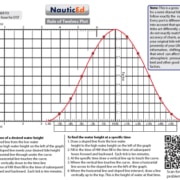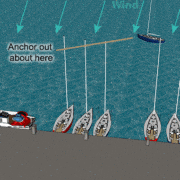Forereaching animation: How to sail in big waves
This post was inspired by the conversation I had with a student sailing off shore in big waves. He was wanting to know how to keep his sails full and have a more comfortable ride whilst sailing downwind. See that conversation here: Wave and Forereaching.
In our storm tactics course, we talk about how forereaching is a way to handle the waves. If you’re going downwind, the waves will still be going faster than you but you can surf them as you go down. As the wave passes underneath and you slide off the back side, your speed will drop significantly. If you don’t turn up wind, the apparent wind will and shift aft and drop way off. The headsail will become shadowed and depowered and your boat speed will drop even further. Your ride will be pretty uncomfortable with an annoyingly flopping head sail.
To keep your boat powered you will want to maintain a constant apparent wind angle to the wind usually about 130 is best and if you’ve take our electronic navigation course dealing with polar plots you’ll learn that you go faster downwind towards your destination by sailing at 130 off the wind rather than directly at at your destination at 180.
In order to maintain a constant apparent wind angle and keep boat speed at it’s maximum, you forereach the waves. This means turning up into the wind as the boat speed slows then turning down wind as the boat begins to surf.
Here is our simple animation. You’ll notice on the wind meter that the apparent wind angle stays constant as you make your turns. The True wind shifts relative to the boat (constant relative to the ground obviously). Press stop/play through out to see what is happening.
Enjoy! Take the NauticEd Storm Tactics Course. You never know when you’re going to need this information and saying “whoops I wish I’d taken that course” is just too darn late!






